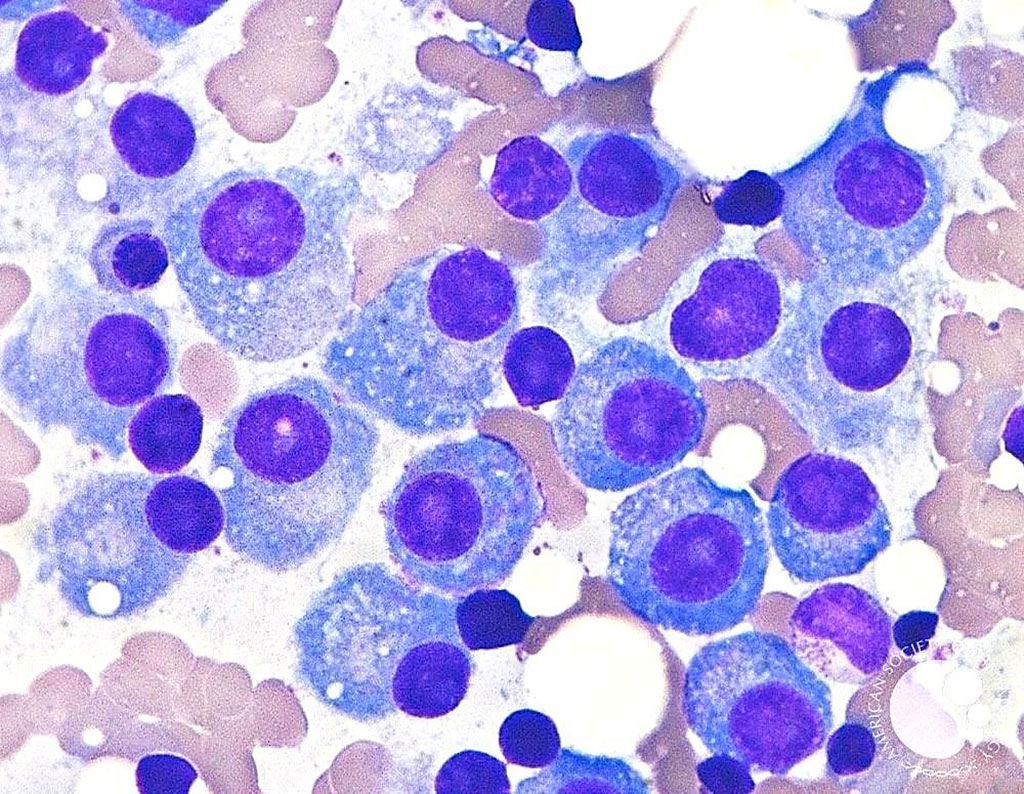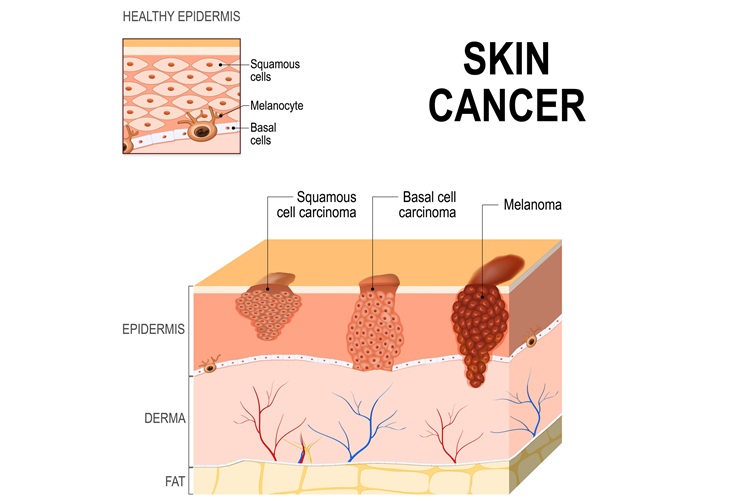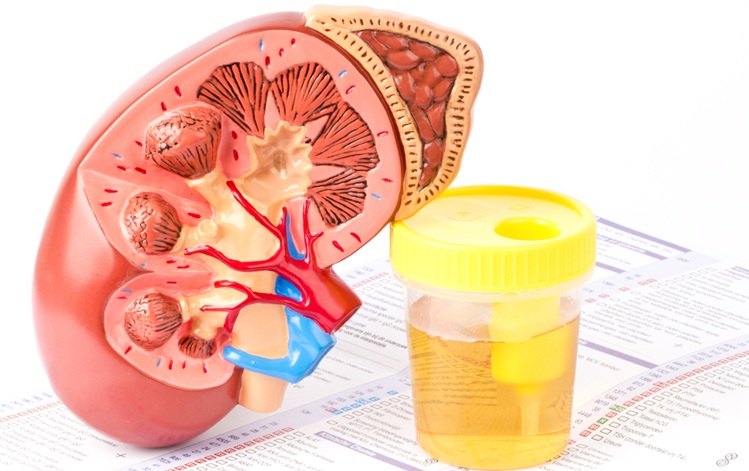Personalized CtDNA Analysis Detects Minimal Residual Disease
|
By LabMedica International staff writers Posted on 08 Jun 2021 |

Image: Bone marrow aspirate showing mature plasma cells with eccentric nuclei and abundant basophilic cytoplasm indicative of multiple myeloma (Photo courtesy of Dr. David Israel Garrido, MD et.al.)
Multiple myeloma (MM), is a type of bone marrow cancer. It is called multiple myeloma as the cancer often affects several areas of the body, such as the spine, skull, pelvis and ribs. Minimal residual disease (MRD) is the name given to small numbers of leukemic cells that remain in the person during treatment, or after treatment when the patient is in remission.
Despite treatment with high-dose chemotherapy followed by autologous stem cell transplantation (AHCT), MM patients invariably relapse. MRD-negativity post-AHCT has emerged as the most important prognostic marker. Currently, MRD in MM is monitored via bone marrow aspirate sampling. Marrow MRD assays are limited by the spatial heterogeneity of marrow MM localization; extramedullary disease and sampling variability of marrow aspiration.
Hematologists at the Medical College of Wisconsin (Milwaukee, WI, USA) and their colleagues, analyzed in a retrospective, single-center study, circulating tumor DNA (ctDNA) MRD in blood samples collected from 28 patients with MM after upfront AHCT. A total of 80 plasma time points were available pre and post AHCT with a median follow-up of 92.4 months. Multiparameter flow cytometry (MFC) at 10-4 level was used to assess the MRD from the BM biopsy.
Individual bone marrow aspirates or Formalin-fixed, Paraffin-embedded (FFPE) slides from the time of MM diagnosis and matched normal blood were whole-exome sequenced, and somatic mutations were identified. MRD assessment at three months post-AHCT was performed by ctDNA analysis using a personalized, tumor-informed Signatera bespoke mPCR NGS assay (Natera Inc, San Carlos, CA, USA). The prognostic value of ctDNA was evaluated by correlating MRD status with clinical outcomes.
The scientists reported that ctDNA was detectable in 17/24 (70.8%) of pre-AHCT, 15/28 (53.6%) of ̃three months post-AHCT, and 11/28 (39.2%) of patients during the surveillance phase post-AHCT. Of the 15 ctDNA MRD positive patients, 93.3% experienced relapse on follow-up (hazard ratio: 5.64). Patients negative for ctDNA at three months post-AHCT had significantly superior progression-free survival (PFS) compared to positive (median PFS, 84 months versus 31 months) The positive predictive value (PPV) for relapse among patients positive for ctDNA at three months post-AHCT was 93.3%, and significantly higher than marrow multiparametric flow cytometry (MFC) of 68.4%.
The authors concluded that their study shows the feasibility that a tumor-informed assay on archival blood samples is predictive of relapse post-AHCT. Future prospective studies with real-time marrow next generation sequencing (NGS) and ctDNA samples are needed to define the role of ctDNA in MM and its prognostic significance. The study was presented at the virtual 2021 ASCO Annual Meeting held June 4-8, 2021.
Related Links:
Medical College of Wisconsin
Natera Inc
Despite treatment with high-dose chemotherapy followed by autologous stem cell transplantation (AHCT), MM patients invariably relapse. MRD-negativity post-AHCT has emerged as the most important prognostic marker. Currently, MRD in MM is monitored via bone marrow aspirate sampling. Marrow MRD assays are limited by the spatial heterogeneity of marrow MM localization; extramedullary disease and sampling variability of marrow aspiration.
Hematologists at the Medical College of Wisconsin (Milwaukee, WI, USA) and their colleagues, analyzed in a retrospective, single-center study, circulating tumor DNA (ctDNA) MRD in blood samples collected from 28 patients with MM after upfront AHCT. A total of 80 plasma time points were available pre and post AHCT with a median follow-up of 92.4 months. Multiparameter flow cytometry (MFC) at 10-4 level was used to assess the MRD from the BM biopsy.
Individual bone marrow aspirates or Formalin-fixed, Paraffin-embedded (FFPE) slides from the time of MM diagnosis and matched normal blood were whole-exome sequenced, and somatic mutations were identified. MRD assessment at three months post-AHCT was performed by ctDNA analysis using a personalized, tumor-informed Signatera bespoke mPCR NGS assay (Natera Inc, San Carlos, CA, USA). The prognostic value of ctDNA was evaluated by correlating MRD status with clinical outcomes.
The scientists reported that ctDNA was detectable in 17/24 (70.8%) of pre-AHCT, 15/28 (53.6%) of ̃three months post-AHCT, and 11/28 (39.2%) of patients during the surveillance phase post-AHCT. Of the 15 ctDNA MRD positive patients, 93.3% experienced relapse on follow-up (hazard ratio: 5.64). Patients negative for ctDNA at three months post-AHCT had significantly superior progression-free survival (PFS) compared to positive (median PFS, 84 months versus 31 months) The positive predictive value (PPV) for relapse among patients positive for ctDNA at three months post-AHCT was 93.3%, and significantly higher than marrow multiparametric flow cytometry (MFC) of 68.4%.
The authors concluded that their study shows the feasibility that a tumor-informed assay on archival blood samples is predictive of relapse post-AHCT. Future prospective studies with real-time marrow next generation sequencing (NGS) and ctDNA samples are needed to define the role of ctDNA in MM and its prognostic significance. The study was presented at the virtual 2021 ASCO Annual Meeting held June 4-8, 2021.
Related Links:
Medical College of Wisconsin
Natera Inc
Latest Molecular Diagnostics News
- Urine Test Detects Early Stage Pancreatic Cancer
- Genomic Test Could Reduce Lymph Node Biopsy Surgery in Melanoma Patients
- Urine Test Could Replace Painful Kidney Biopsies for Lupus Patients
- Blood Test Guides Post-Surgical Immunotherapy for Muscle-Invasive Bladder Cancer
- Mitochondrial DNA Mutations from Kidney Stressors Could Predict Future Organ Decline
- Blood Test Could Predict Bariatric Surgery Outcomes in Teenagers
- ctDNA Blood Test to Help Personalize Postsurgical Colon Cancer Treatment
- AI Powered Blood Test Predicts Suicide Risk in Bipolar Patients
- DNA Sensor Enables Molecular Detection from Single Blood Drop
- DNA-Powered Test Accurately Detects E. Coli Lookalike Bacteria
- World’s Fastest DNA Sequencing Technique to Revolutionize NICU Genomic Care
- Blood Test Uses Cell-Free DNA to Detect ALS Faster and More Accurately
- Multi-Cancer Early Detection Blood Test Increases Cancer Detection
- Portable Label-Free Device Tracks Alzheimer's Disease in Real Time
- Liquid Biopsy Test Enables Early Detection of ICI-Related Myocarditis
- Rapid POC Diagnostic Test Detects Asymptomatic Malaria Cases
Channels
Clinical Chemistry
view channel
VOCs Show Promise for Early Multi-Cancer Detection
Early cancer detection is critical to improving survival rates, but most current screening methods focus on individual cancer types and often involve invasive procedures. This makes it difficult to identify... Read more
Portable Raman Spectroscopy Offers Cost-Effective Kidney Disease Diagnosis at POC
Kidney disease is typically diagnosed through blood or urine tests, often when patients present with symptoms such as blood in urine, shortness of breath, or weight loss. While these tests are common,... Read moreMolecular Diagnostics
view channel
Urine Test Detects Early Stage Pancreatic Cancer
Pancreatic cancer remains among the hardest cancers to detect early. In the UK, around 10,000 people are diagnosed each year, but only 5% survive beyond five years. Late diagnosis is a major factor—more... Read more
Genomic Test Could Reduce Lymph Node Biopsy Surgery in Melanoma Patients
Accurately determining whether melanoma has spread to the lymph nodes is crucial for guiding treatment decisions, yet the standard procedure—sentinel lymph node biopsy—remains invasive, costly, and unnecessary... Read moreImmunology
view channel
Blood-Based Liquid Biopsy Model Analyzes Immunotherapy Effectiveness
Immunotherapy has revolutionized cancer care by harnessing the immune system to fight tumors, yet predicting who will benefit remains a major challenge. Many patients undergo costly and taxing treatment... Read more
Signature Genes Predict T-Cell Expansion in Cancer Immunotherapy
Modern cancer immunotherapies rely on the ability of CD8⁺ T cells to rapidly multiply within tumors, generating the immune force needed to eliminate cancer cells. However, the biological triggers behind... Read moreMicrobiology
view channel
High-Throughput Enteric Panels Detect Multiple GI Bacterial Infections from Single Stool Swab Sample
Gastrointestinal (GI) infections are among the most common causes of illness worldwide, leading to over 1.7 million deaths annually and placing a heavy burden on healthcare systems. Conventional diagnostic... Read more
Fast Noninvasive Bedside Test Uses Sugar Fingerprint to Detect Fungal Infections
Candida bloodstream infections are a growing global health threat, causing an estimated 6 million cases and 3.8 million deaths annually. Hospitals are particularly vulnerable, as weakened patients after... Read morePathology
view channel
New Molecular Analysis Tool to Improve Disease Diagnosis
Accurately distinguishing between similar biomolecules such as proteins is vital for biomedical research and diagnostics, yet existing analytical tools often fail to detect subtle structural or compositional... Read more
Tears Offer Noninvasive Alternative for Diagnosing Neurodegenerative Diseases
Diagnosing and monitoring eye and neurodegenerative diseases often requires invasive procedures to access ocular fluids. Ocular fluids like aqueous humor and vitreous humor contain valuable molecular information... Read moreTechnology
view channel
Cell-Sorting Device Uses Electromagnetic Levitation to Precisely Direct Cell Movement
Sorting different cell types—such as cancerous versus healthy or live versus dead cells—is a critical task in biology and medicine. However, conventional methods often require labeling, chemical exposure,... Read more
Embedded GPU Platform Enables Rapid Blood Profiling for POC Diagnostics
Blood tests remain a cornerstone of medical diagnostics, but traditional imaging and analysis methods can be slow, costly, and reliant on dyes or contrast agents. Now, scientists have developed a real-time,... Read moreIndustry
view channel
Qiagen Acquires Single-Cell Omics Firm Parse Biosciences
QIAGEN (Venlo, Netherlands) has entered into a definitive agreement to fully acquire Parse Biosciences (Seattle, WA, USA), a provider of scalable, instrument-free solutions for single-cell research.... Read more
Puritan Medical Products Showcasing Innovation at AMP2025 in Boston
Puritan Medical Products (Guilford, ME, USA), the world’s most trusted manufacturer of swabs and specimen collection devices, is set to exhibit at AMP2025 in Boston, Massachusetts, from November 11–15.... Read more
Advanced Instruments Merged Under Nova Biomedical Name
Advanced Instruments (Norwood, MA, USA) and Nova Biomedical (Waltham, MA, USA) are now officially doing business under a single, unified brand. This transformation is expected to deliver greater value... Read more























